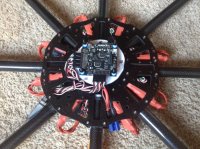stainless steel. was just ordering from mcmaster.com and was interested in that two SS options were there for metric hardware, 316 and 18-8
from wikipedia
Ferritic and
martensitic stainless steels are magnetic.
Austenitic stainless steels are non-magnetic.
[h=2]Types of stainless steel[/h]

 Pipes
Pipes and
fittings made of stainless steel
There are different types of stainless steels: when
nickel is added, for instance, the austenite structure of iron is stabilized. This crystal structure makes such steels virtually non-
magnetic and less
brittle at low temperatures. For greater
hardness and strength, more
carbon is added. With proper
heat treatment, these steels are used for such products as
razor blades, cutlery, and tools.
Significant quantities of
manganese have been used in many stainless steel compositions. Manganese preserves an austenitic structure in the steel, similar to nickel, but at a lower
cost.
Stainless steels are also classified by their
crystalline structure:
- Austenitic, or 300 series, stainless steels have an austenitic crystalline structure, which is a face-centered cubic crystal structure. Austenite steels make up over 70% of total stainless steel production. They contain a maximum of 0.15% carbon, a minimum of 16% chromium and sufficient nickel and/or manganese to retain an austenitic structure at all temperatures from the cryogenic region to the melting point of the alloy. The most widely used austenite steel is the 304 grade or A2 stainless steel (not to be confused with A2 grade steel, also named Tool steel, a steel). The second most common austenite steel is the 316 grade, also called marine grade stainless, used primarily for its increased resistance to corrosion. A typical composition of 18% chromium and 10% nickel, commonly known as 18/10 stainless, is often used in cutlery and high quality cookware. 18/0 and 18/8 are also available.
Superaustenitic stainless steels, such as alloy
AL-6XN and 254SMO, exhibit great resistance to chloride pitting and crevice corrosion because of high
molybdenum content (>6%) and nitrogen additions, and the higher nickel content ensures better resistance to stress-corrosion cracking versus the 300 series. The higher alloy content of superaustenitic steels makes them more expensive. Other steels can offer similar performance at lower cost and are preferred in certain applications, for example ASTM A387 is used in pressure vessels but is a low alloy carbon steel with a chromium content of 0.5% to 9%.[SUP]
[19][/SUP] Low-carbon versions, for example
316L or 304L, are used to avoid corrosion problems caused by welding. Grade 316LVM is preferred where
biocompatibility is required (such as body implants and piercings).[SUP]
[20][/SUP] The "L" means that the carbon content of the alloy is below 0.03%, which reduces the
sensitization effect (precipitation of
chromium carbides at grain boundaries) caused by the high temperatures involved in welding.
- Ferritic stainless steels generally have better engineering properties than austenitic grades, but have reduced corrosion resistance, because of the lower chromium and nickel content. They are also usually less expensive. They contain between 10.5% and 27% chromium and very little nickel, if any, but some types can contain lead. Most compositions include molybdenum; some, aluminium or titanium. Common ferritic grades include 18Cr-2Mo, 26Cr-1Mo, 29Cr-4Mo, and 29Cr-4Mo-2Ni. These alloys can be degraded by the presence of
chromium, an intermetallic phase which can precipitate upon welding.
- Martensitic stainless steels are not as corrosion-resistant as the other two classes but are extremely strong and tough, as well as highly machinable, and can be hardened by heat treatment. Martensitic stainless steel contains chromium (12–14%), molybdenum (0.2–1%), nickel (less than 2%), and carbon (about 0.1–1%) (giving it more hardness but making the material a bit more brittle). It is quenched and magnetic.
- Precipitation-hardening martensitic stainless steels have corrosion resistance comparable to austenitic varieties, but can be precipitation hardened to even higher strengths than the other martensitic grades. The most common, 17-4PH, uses about 17% chromium and 4% nickel.
- Duplex stainless steels have a mixed microstructure of austenite and ferrite, the aim usually being to produce a 50/50 mix, although in commercial alloys the ratio may be 40/60. Duplex stainless steels have roughly twice the strength compared to austenitic stainless steels and also improved resistance to localized corrosion, particularly pitting, crevice corrosion and stress corrosion cracking. They are characterized by high chromium (19–32%) and molybdenum (up to 5%) and lower nickel contents than austenitic stainless steels.
The properties of duplex stainless steels are achieved with an overall lower alloy content than similar-performing super-austenitic grades, making their use cost-effective for many applications. Duplex grades are characterized into groups based on their alloy content and corrosion resistance.
- Lean duplex refers to grades such as UNS S32101 (LDX 2101), S32304, and S32003.
- Standard duplex is 22% chromium with UNS S31803/S32205 known as 2205 being the most widely used.
- Super duplex is by definition a duplex stainless steel with a pitting corrosion equivalent (PRE) > 40, where PRE = %Cr + 3.3x(%Mo + 0.5x%W) + 16x%N. Usually super duplex grades have 25% chromium or more and some common examples are S32760 (Zeron 100), S32750 (2507) and S32550 (Ferralium),.
- Hyper duplex refers to duplex grades with a PRE > 48 and at the moment only UNS S32707 and S33207 are available on the market.





